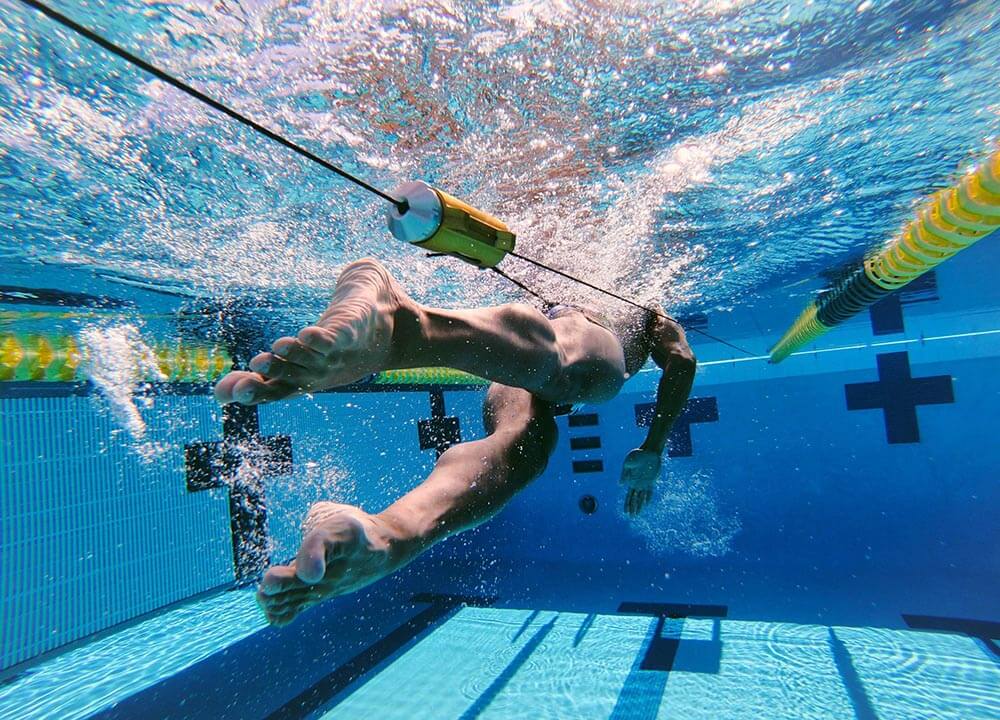Strength, Speed, Explosiveness: The Benefits of Power Workouts in the Pool

Every swimmer loves a good power workout. What is better than a practice full of short reps, lots of rest and a whole lot of speed? Power practices are designed for swimmers to not only train fast, but can be accomplished while wearing resistance gear. Resistance training and speed are the two biggest elements that go into creating a power workout. Many coaches write power practices that involve the use of equipment like power towers, racks, DragSox, GMX7, StretchCordz, parachutes, etc.
What Makes a Power Workout Beneficial for Swimmers?
Swimming is not typically built around the concept of resistance training, but that does not mean it isn’t helpful. Power workouts allow swimmers to go fast for a short period of time, all while being weighed down or restricted in their movement through the water. The point of training this way is for swimmers to practice training hard and fast while being held back, so that they can build strength in the water to swim even faster once they take their resistance gear off. Power workouts give swimmers a different feel for the water from what they get from a typical swim practice. Incorporating power workouts into your swim training schedule one or two times a week may help swimmers build quick speed, explosiveness and strength in the water which will only help them in the long run.
Read below to learn more about the different resistance training tools and how swimmers use them.
Power Towers (Buckets)
Power Towers, commonly known as buckets, are a great tool for swimmers to use for resistance training. Buckets are set up so that swimmers wear a belt that connects to the bucket. As you swim forward, the bucket moves upward. The buckets fill with water and the more it is filled, the heavier it is and the harder it will be to swim. Once you take the belt off, you will feel like you are flying through the water.
Racks
Racks are used similarly to the way that Power Towers are used. Swimmers wear a belt that is attached to a tall rack made up of several 5- or 10-pound weights. Swimmers will choose an appropriate weight that they are comfortable pulling through the water. Once you swim about 12 yards, the weight will hit the top of the rack, ultimately not allowing the swimmer to move any further. Swimmers feel the resistance right when they push off the wall which helps build strength and explosiveness for their turns and walls.
DragSox
DragSox, or sox for short, are used very differently compared to the first two power tools, but all three aim to accomplish the same task. Swimmers typically wear DragSox on their feet or around their ankles, but occasionally some may wear them around their arms. Sox are a mesh material that has holes to allow water to escape through. The purpose behind wearing sox is to create drag and make it harder to swim and kick. Once you take your sox off, you should feel super speedy in the water.
GMX7
GMX7 is not only used as a resistance tool, but it also helps with stroke correction and alignment in the water. This tool can stretch from 25 yards to 50 meters, depending on the length of the pool. Given the long range that the cord can stretch, swimmers have the ability to do flip turns and swim bi-directionally. Swimmers wear a belt which is connected to the GMX7 string aligned along the lane line. The GMX7 ranges from no resistance to immovable resistance. Swimmers can move the resistance easily based off the set that they are doing. The resistance stays constant the entire time that you swim. The only way it changes is if you move the knob between reps. This is a great tool for swimmers to use as they can choose exactly how much resistance they want to use, and they can swim as many laps as they need to without the concern of running out of string.
StretchCordz
StretchCordz, aka cordz, are another commonly used resistance tool used among swimmers. Similarly to many of the other pieces of equipment, swimmers wear a belt which attaches to a stretchy cord. Cordz are used in many ways whether somebody holds the handle of the cord, or ties it to the block or lane line. This tool restricts swimmers from moving easily, so it takes speed and strength to continue going forward. Cordz help develop speed and explosiveness off the walls.
Parachutes
If there is a resistance tool that most swimmers dread using, it’s parachutes. Parachutes are designed so that swimmers can wear the belt around their waste while the parachute drags behind them. The purpose of a parachute is to catch water while you swim, making it very difficult to move forward at a fast pace. This resistance tool is bound to get your heart pumping and working hard to move through the water.
On top of the many resistance tools that coaches will have their athletes use during power workouts, there are numerous other ways that athletes can train to build strength, speed, and explosiveness. Coaches will often times write power sets that involve fins or the use of starting blocks to hone in on the aspect of speed and explosiveness. Running dives and reaction time sets are a couple more beneficial activities to incorporate into power practices too!
I hope you enjoyed reading about the benefits of power practices, as well as the various resistance training tools that swimmers use outside of their everyday equipment from their mesh bags. What is your favorite piece of power training gear?



